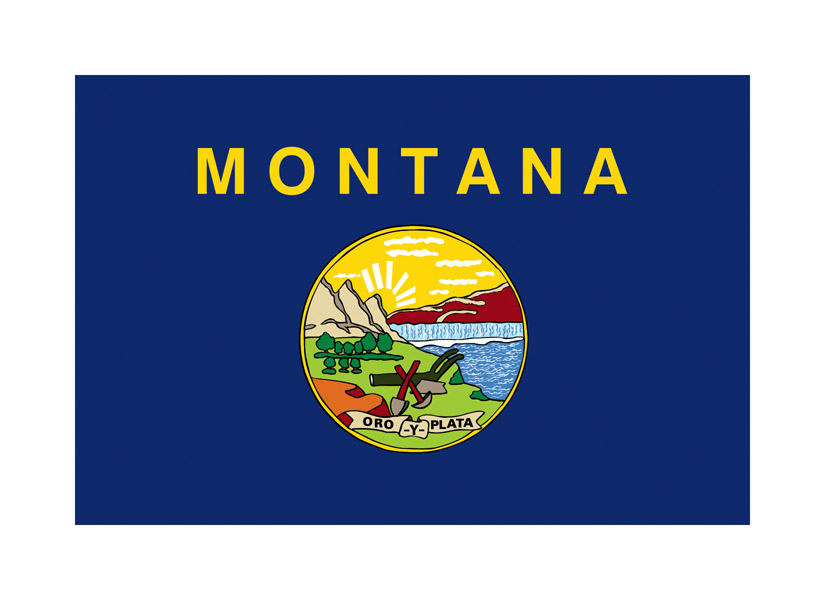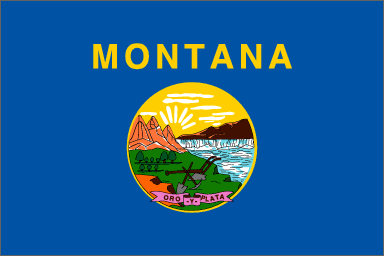Date First Used
1905
Nickname(s)
None
Design Elements
Blue background with the state seal and the word "Montana" in yellow above it, both centered on the flag. Gold fringe on the top and bottom borders only.
Symbols: The state seal. Montana scenery including mountains, forests, plains, and the Missouri River's Great Falls represent the state. In the foreground, a pick, shovel, and plow stand for farming and mining, the state's important early industries. A ribbon with Montana's state motto, Oro y plata, meaning gold and silver in Spanish, appears near the bottom of the seal.
Colors: Blue, yellow, green, gray, rose, orange, and brown. Blue is a common color for military flags and usually symbolizes loyalty. The other colors give the image a realistic appearance.
Proportions: 2:3, 3:5, or 5:8
Variations: None
History
The prototype for Montana's flag was displayed by the First Montana Infantry Unit as they went off to the Spanish-American War in 1898. This flag was the brainchild of Colonel Harry C. Kessler, who prepared the volunteer soldiers for war. The unit already had a U.S. flag, but Kessler thought they should have a unique emblem. He personally commissioned a blue flag with the Montana state seal embroidered on it, and the words "1st Montana Infantry U.S.V." above. The Montana soldiers carried it with them throughout the war and returned it to the state afterward. Awareness of the flag had grown as news from the war filtered home. Kessler gave his flag to the state's governor, who in turn had it displayed around the state. People began to feel that Kessler's flag could make a suitable state flag. The flag law eventually came before the state legislature in 1905 and passed. The new legal flag was to be identical to the First Montana Infantry flag, but without the words "1st Montana Infantry U.S.V." above the seal.
The flag proved difficult to reproduce given the complex design and colors, but it has flown largely unchanged since its adoption. The word Montana was added above the seal in 1981 to better distinguish the flag from all the other dark blue flags with state seals that had been adopted over the years. The colors in the flag were more clearly defined at the same time. In 1985, the typeface for the word Montana had to be specified because too many different versions of the flag had gone into circulation.
Proper Uses
The Montana flag is generally displayed at state offices and agencies. The flag should be treated with respect. When it is displayed alongside other states' flags within Montana, it usually occupies the place of honor. The flag of Montana flies below the U.S. flag when they fly together.
The Montana flag should be hoisted briskly but lowered ceremoniously. It should not be allowed to touch the ground during hoisting or lowering and should hang or fly clear of water, the ground or floor, and anything else beneath it. It is recommended that the flag not fly upside down. It should preferably not be handled in a way likely to soil, tear, or destroy it. When the flag is torn or soiled and can't be hoisted or displayed in public, it is preferable that it be destroyed by burning in a private ceremony, not in public. The flag usually flies only between sunrise and sunset. If it is displayed after dark, it should be properly lit.
Legends, Controversies, and Trivia
Before Kessler's flag, the Montana state seal was usually reproduced in black and white. Kessler asked the seamstress who embroidered the flag to use realistic colors, but left the choice of colors up to her. Later, when the prototype was reproduced as a state flag, efforts were made to imitate the original colors, although the flag had been to the Philippines and back and was somewhat faded as a result.
Copyright © 1993-2025 World Trade Press. All rights reserved.



